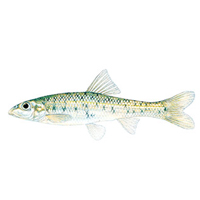Gravel chub
Scientific name: Erimystax x-punctata

Cover photo credit: J.D. Taylor
Status
Extirpated
“ Extirpated ” means the species lives somewhere in the world, and at one time lived in the wild in Ontario, but no longer lives in the wild in Ontario.
Date added to the Species at Risk in Ontario List
The gravel chub was listed as extirpated when the Endangered Species Act took effect in 2008.
Read the most recent assessment report (PDF)
What it looks like
The Gravel Chub is a small, slender minnow reaching a maximum of 11 centimetres in length. The body color is olive green or brown on top and silvery- white on the belly, with distinctive X- and Y-shaped markings along the side. It has large eyes positioned toward the top of the head and its snout overhangs the mouth, with small fleshy "whiskers" or barbels at the corner of its mouth.
Where it lives
The Gravel Chub, as its name suggests, has specific habitat requirements of clear, flowing waters with gravely bottoms, and enough current to keep the bottom silt-free.
Where it’s been found in Ontario
In Canada, the historical range for this species was a single watershed in southwestern Ontario, where it was found at two locations in the Thames River. However, it has not been recorded here since 1958, and there is no current evidence of reproducing populations anywhere in Canada.
The range of the Gravel Chub is widespread across central United States, but patchily distributed, extending from south-central Arkansas north to southern Minnesota and east to western New York.
View a larger version of this map (PDF)
Why it disappeared from Ontario
The Gravel Chub was likely never common in Ontario, but its decline and extirpation here was likely due to siltation and sedimentation of the Thames River from farmland runoff. The Gravel Chub is declining throughout its North American range, largely due to habitat degradation and its sensitivity to siltation.
Action we are taking
Extirpated species and their habitat are protected if the species are again found in Ontario.
Help make sure we don’t lose more endangered species in Ontario
- The Ministry of Natural Resources and Forestry tracks species at risk such as the Gravel Chub. You can use a handy online form to report your sightings to the Natural Heritage Information Centre. Photographs with specific locations or mapping coordinates are always helpful.
- Farmers and land owners can help improve fish habitat and keep Ontario’s water safe and clean by maintaining natural vegetation next to creeks and rivers, and keeping pollution and soil from washing into Ontario’s streams and rivers. You can find more information about programs and funding assistance for eligible farmers from the Ontario Soil and Crop Improvement Association website.
- Report any illegal activity related to plants and wildlife to
1-877-TIP-SMNR (847-7667) . - Private land owners have an important role to play in species recovery. You may be eligible for stewardship programs that support the protection and recovery of species at risk and their habitats.
- Volunteer with a local nature club or provincial park to participate in surveys or stewardship work focused on species at risk.
Quick facts
- The bottom-feeding Gravel Chub uses sensitive barbels, or whiskers, at the corners of its mouth to find its prey of small insects and larvae by probing under rocks and in crevices.
